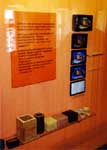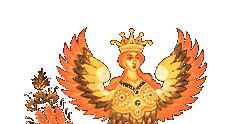Kholuy and Mstera
During our three-day visit to the villages of Palekh, Kholuy, and Mstera, the village of Kholuy was our 'home base'. We were actually spending time there Sunday night when we first arrived, and then during the morning and night of Monday. On Tuesday, we left to go back to Palekh to visit the museum there, and then drove on to Mstera, then back to Moscow. The time we spent in Kholuy was wonderful, and we accomplished a great deal. But there were two unfortunate things about my visit there. First, I didn't get a chance to visit the museum--it turned out that the museum is closed on Mondays, and we arrived too late on Sunday to get in. Second, the few photos that I took of the village didn't turn out well enough to post on the web. If only memories were downloadable!
After arriving in Kholuy and having dinner at a friend's house, we walked over to see the acclaimed Sergey Deviatkin. Seeing him for the first time in person, my first impression was that he looks much better than in his pictures on our website. If not photogenic, Sergey is definitely a humorous, easy-going, and slightly elusive person. He had a couple works in progress to show us, and we talked about some plans for new boxes. While we were there, Andrey Bayov stopped by. They are related by marriage, one of them married the other's sister I believe, and are good friends. They are often at each other's home, and that is how Andrey knew we were going over to Sergey's--we were calling around trying to find him since his phone wasn't working. Bayov had some things ready to show us, and we interview him and purchased one of his pieces. He's shaved his beard since the photograph on our website was taken, but is still as jolly as ever. Deviatkin then accompanied us to a few places in our car, including the store that is just outside of Kholuy (Russian carpooling).
Some of the other artists we visited included Vladimir Blinov from whom we purchased a box, Boris Novosiolov from whom we ordered a new box, and Sergey Zakharov, who again declined to let us do an interview with him (next time!). We did have some better success at the Kholuy factory. There we looked through a whole room of ready articles, painted by factory-employed artists, as well as some original works that the Factory purchased from Kholuy artists. In walking between the director's room and the accountant's room, I was able to peak into a few of the large rooms where the artists carry out their work. Most of the rooms were large, with space enough for six or eight desks to be comfortably arranged, and they were bright and colorful. We also stopped into the 'Komnata Glavnovo Khudozhnika' (Head Artist's Room) to say hi to Deviatkin again. He spends his time in the Factory building there, even though he's no longer in that official position.
Kholuy is divided by the little Teza River than runs through it. Although it was still the last bit of winter there, everyone in Kholuy was talking about the pending razliv, or flood, when the snows melt. As we would cross over the river, I could envision the waters rising up above the banks, engulfing the bridge that connects the majority of the village to the main road and the Factory. Nearly everyone has a small boat or a raft, and from among them, in my mind's eye, I see Ded Mazay rafting from shrinking island to shrinking island collecting the rabbits he hunts in the other times of the year to bring them to safety.
We spent about half a day in Mstera, and the pace was quick. We made a list of whom we needed to visit, making the factory and museum our last stop. It was a great thing to meet the artists whose works of art I had been handling so often, to see them in person, hear their speech, observe their mannerisms, and look over their workspaces and living arrangements. Building materials in Russia are becoming not only less expensive, but readily available--previously not the case. Many of the people in the villages were either building new homes or going through extensive remodeling. This was more common in the other three villages than in Mstera, since Mstera is by far the larger of the four with more apartments than private homes. But nonetheless, the elite artists are no longer the only ones with beautiful new residences.
Of the artists in Mstera, we visited a few of the more popular ones. Our first stop was Danil Molodkin. We looked over his photo album and found a rare piece that we requested him to paint for us. We also interviewed him for his online profile. From there, we went over to the Sosins' apartment, where we met not only Piotr Sosin, but also his daughter Tanya Strunina and her husband Mikhail. We bought pieces from both Piotr and Tanya, including two large pieces of Piotr's that were just returned to him from recent exhibitions. From there we stopped in at Vladimir Molodkin's home, with the intent of looking at new pieces from him and interview his wife, but he had nothing new and she wasn't home. But he promised to give her the form to fill out for later, since we have several pieces by her at the moment.
  The Mstera Museum was the only place I visited that required us to don makeshift slippers over our shoes (including the Tretyakov Gallery!). Part of the displays were temporarily removed to make way for another exhibition, but we headed straight for what lacquer art there was. The icon display was interesting because it had samples of the gold and silver metalworking and the tools that are used to fashion them. As we turned the corner, there was a young icon painter behind a table copying a medium-size icon from one of the displays. After making him sufficiently nervous by observing him for a moment, he declined to have his picture taken. The displays were nicely organized by time period and by artist, with pictures of the more renowned painters and some information about them next to their works. However, the glass used for the cabinets was so wavy that it made the head spin to look in at the boxes. It also negated any detail in the photographs I took there, so I regret not being able to share the collection through pictures.
Overall, the trip to the villages was replete with little nuances and adventures, like trying to navigate the snow and ice covered streets in the villages, the huge potholes in the roads, pulling another car from just outside of Palekh to Yuzha, trying to help a drunk old man, and getting mildly stuck in the snow in Kholuy. I could sense the slower pace of life that reigned in the villages, and began to understand how the patience required to paint lacquer miniature was acquired. As we reimmersed ourselves in the traffic, noise, hustle and bustle of Moscow, I contemplated on this delicate art being slowly but purposefully produced in the unforgettable villages of Fedoskino, Palekh, Kholuy, and Mstera. In a complex life, it's a comfort to sometimes lose ourselves in the beauty and elegance of Russian lacquer miniature.
The Mstera Museum was the only place I visited that required us to don makeshift slippers over our shoes (including the Tretyakov Gallery!). Part of the displays were temporarily removed to make way for another exhibition, but we headed straight for what lacquer art there was. The icon display was interesting because it had samples of the gold and silver metalworking and the tools that are used to fashion them. As we turned the corner, there was a young icon painter behind a table copying a medium-size icon from one of the displays. After making him sufficiently nervous by observing him for a moment, he declined to have his picture taken. The displays were nicely organized by time period and by artist, with pictures of the more renowned painters and some information about them next to their works. However, the glass used for the cabinets was so wavy that it made the head spin to look in at the boxes. It also negated any detail in the photographs I took there, so I regret not being able to share the collection through pictures.
Overall, the trip to the villages was replete with little nuances and adventures, like trying to navigate the snow and ice covered streets in the villages, the huge potholes in the roads, pulling another car from just outside of Palekh to Yuzha, trying to help a drunk old man, and getting mildly stuck in the snow in Kholuy. I could sense the slower pace of life that reigned in the villages, and began to understand how the patience required to paint lacquer miniature was acquired. As we reimmersed ourselves in the traffic, noise, hustle and bustle of Moscow, I contemplated on this delicate art being slowly but purposefully produced in the unforgettable villages of Fedoskino, Palekh, Kholuy, and Mstera. In a complex life, it's a comfort to sometimes lose ourselves in the beauty and elegance of Russian lacquer miniature.
|



